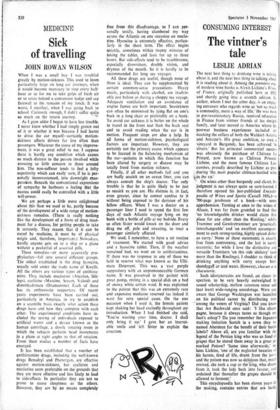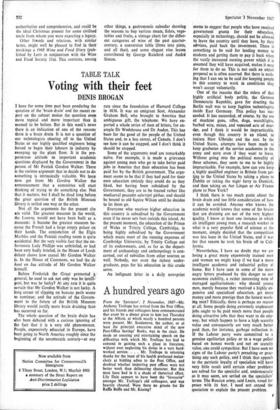The vintner's tale
CONSUMING INTEREST LESLIE ADRIAN
The next best thing to drinking wine is talking about it, and the next best thing to talking about it is reading about it. Among the premiers crul of modern wine books is Alexis Lichines Wines of France. originally published here in 1952 and shortly going into a seventh edition. Its author, whom I met the other day, is an engae.. ing extrovert who regards wine as 'not so much a commodity, more a way of life.' He was born in pre-revolutionary Russia. received education in France from vintner friends of his émigré family, and later moved to America where his postwar business experiences included re- stocking the cellars of both the Waldorf-Astoria and Antoine's. His great ambition, to own a vineyard in Burgundy, has been achieved 'in slivers.' But his principal commercial success was obviously the purchase of Château Le Prieure, now known as Château Prieure. Lichine, and the more famous Château Las- combes, proudly described by Lichine as pro- ducing 'the most popular château-bottled wine 4in the us.'
On wines other than burgundy and claret, his judgment is not always quite so sure-footed. I therefore opened his just-published Encyclo- paedia of Wines and Spirits (Cassell 105s.)—a 700-page jeroboam of a book—with some apprehension. Turning at once to the wines of Alsace, I was far from gruntled to find that `no knowledgeable drinker would claim first place for any other than the Riesling.' whil,t Traminer and Gewfirztraminer are 'practicall, interchangeable' and 'an excellent accompani- ment to such strong-tasting, highly spiced dishes as. curry.' None of these statements is exacth free from controversy, and the last is surel eccentric; for while I love the distinctive and versatile Traminers 'on this side idolatry' (and more than the Rieslings), I shudder to think ot drinking anything with curry except beer. shandygaff or iced water. However, chacun a )a chacunerie.
Such idiosyncrasies are found, on closer in- spection. to be very heavily outweighed by sound scholarship, mellow common sense and (not least) wide-ranging anecdotage. Were you aware that George Washington was launched on his political career by distributing run) among the voters of Virginia? Did you knou that Art Buchwald once said: 'I like cham- pagne, because it always tastes as though mt foot's asleep'? Do you remember the Japanese making imitation Scotch in a town they re- named Aberdeen for the benefit of their bottle labels? Above all, are you familiar with ths! legend of the Persian king who was so fond of grapes that he stored them away in a great jar marked Poison? 'Some time afterwards,' re: lates Lichine, 'one of the neglected beauties ot his harem, tired of life, drank from the jar— and the poison was now so delicious that, much revived, she took a cup to the king, who drank from it, took the lady back into favour, and ordained that thereafter the grapes should be allowed to ferment.' .
This encyclopaedia has been eleven years in the making, contains entries that are lucid. authoritative and comprehensive, and could be the ideal Christmas present for some civilised uncle from whom you were expecting a legacy.
Other friends and relations, with similar tastes, might well be pleased to find in their stockings a 1968 Wine and Food Diary (pub- lished by Letts in conjunction with the Wine and Food Society 11s). This contains, among
other things, a gastronomic calendar showing the seasons to buy various meats, fishes, vege- tables and fruits, a vintage chart for the differ- ent categories of wine of the past quarter- century, a conversion table (litres into pints, and all that), and some elegant vine leaves contributed by George Rainbird and Andro Simon.











































 Previous page
Previous page